Business in Ecuador, Guayaquil, Quito

Ecuador: leading exporter of bananas. Ecuadorian Foreign Trade: fruits, flowers
- Introduction to the Republic of Ecuador (Andean Community)
- Business in Guayaquil and Quito
- Ecuadorian Economy
- International Trade of Ecuador
- Customs of Ecuador
- Import and export formalities
- Investment in Ecuador
- Case Study: Business Opportunities in
- Industrial sector
- Fashion and accessories
- Services
- Agribusiness sector. Case Study:
- UBESA
- Holding Favorite Fruit Company
- Case Study: Manta-Manaus Multimodal Transport Infrastructure in Ecuador
- Access to the Ecuadorian Market
- Business Plan for Ecuador
The objectives of the subject “International Trade and Business in Ecuador” are the following:
- To analyze the Ecuadorian Economy and Global Trade
- To know the trade opportunities in Ecuador
- To explore the Ecuadorian trade relations with the country of the student
- To know the Ecuadorian Trade Agreements
- To examine the profile of Ecuadorian Companies
- To develop a business plan for the Ecuadorian Market

The Subject “Foreign Trade and Business in Ecuador” belongs to the following Online Programs taught by EENI Global Business School:
Masters: International Business, Foreign Trade.
Doctorate: American Business, World Trade.

Languages:  or
or  Ecuador
Ecuador  Equateur
Equateur  Equador.
Equador.
- Credits: 1

- Duration: one week
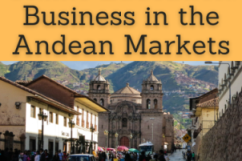
International Trade and Business in Ecuador
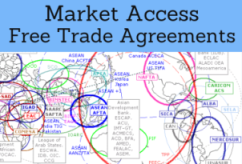
- Ecuador and the Latin American Economic Area
- Andean Community
- Andean Community Trade Agreements: MERCOSUR, Chile, Mexico, Panama, and the EU
- Union of South American Nations (UNASUR)
- Latin American Integration Association (ALADI)
- Latin American and Caribbean Economic System
- Mexico-Ecuador Economic Complementation Agreement
- El Salvador-Ecuador Agreement
- UK-Ecuador-Peru Free Trade and Economic Integration Agreement
- Global System of Trade Preferences
- MERCOSUR (Associate)
- SICA (observer country)
The Republic of Ecuador retired from the Bolivarian Alliance for the Peoples of Our America (ALBA) in 2018.
- Ecuador seeks to join the Pacific Alliance after its departure from the ALBA
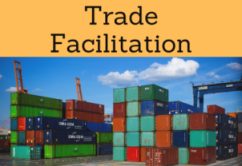
- WTO
- GATS
- Agreement on Sanitary Measures
- Agreement on Technical Barriers to Trade
- Agreement on Preshipment Inspection
- Agreement on Safeguards
- Trade Facilitation Agreement
- WCO
- Hamburg Rules (Sea)
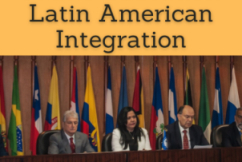
- Inter-American Development Bank
- OAS
- ECLAC
- Summit South American-Arab Countries
- Africa-South America Summit
- East Asia-Latin America Cooperation
- CELAC
- EU-CELAC Summit
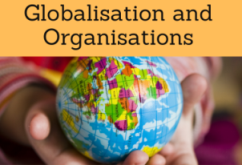
- UN
- UNCTAD
- ITC
- UNCITRAL
- WIPO
- OPEC Fund for International Development (OFID)
- WB
- WTO
- IMF
- PEEC
- Borders of Ecuador: Colombia and Peru
- Ecuadorian Capital: Quito
- Guayaquil is the second-largest Ecuadorian city
- Official language of Ecuador: Spanish
- Ecuadorian population: 15.7 million people
- Ecuadorian Area: 283,561 km²
- Ecuadorian currency: Dollar USD
- Abolition of Slavery in Ecuador: 1851
- African Diaspora in Ecuador: 1.1 million people (7.2% of Ecuadorian population)
- Independence of Ecuador from Spain: 1809, recognized in 1830
Main religion in Ecuador: Christianity (Catholicism: 13 million).
Ecuador belongs to the Latin American Economic Area (Western Civilization).

Ecuadorian Economy.
- Ecuador benefits from his strategic position that provides the direct access to the East Asian markets and the Western Coast of the U.S.
- Its proximity to the Panama Canal permits safe access to Europe, the U.S., Africa, the Middle East, and Asia
- The Ecuadorian economy is the eighth largest economy in Latin America after Brazil, Mexico, Argentina, Chile, Colombia, Venezuela, and Peru
- The Dollarization of Ecuador creates an advantage negotiating with a strong currency (since January 2000, the U.S. Dollar is the official currency)
- Petrol, manufacturing, commerce, and agricultural production are the pillars of the Ecuadorian economy
- Petrol accounts for 40% of the Ecuadorian exports, petroleum exports allow having a positive trade balance
- Ecuadorian GDP growth: 3.8% (economic slowdown)
- Inflation of Ecuador: 3.7%
- Tax reform in Ecuador in 2014. Tax amnesty in 2015
- The Union of South American Nations (UNASUR) is in Quito
- Ecuador is a leader in bananas, shrimp, fresh tilapia, tuna, fine cocoa, passion fruit concentrate, palm, pond, leaf snuff, and broccoli production
Global Trade and Business in Ecuador:
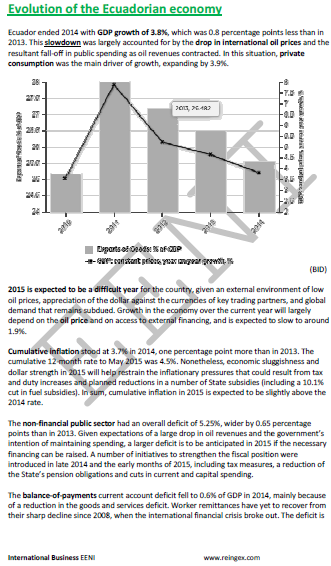
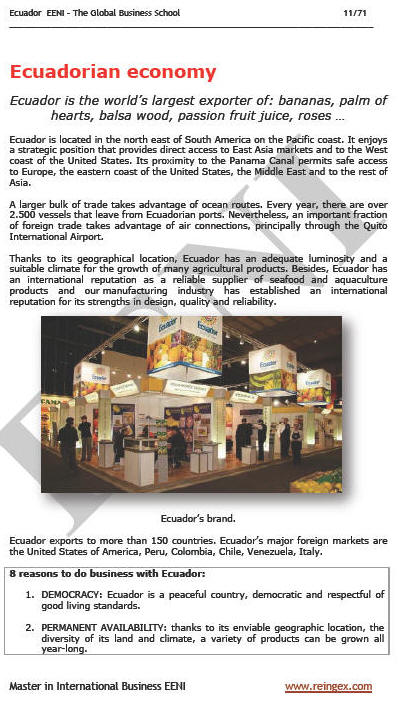
The main activity of the Holding Favorite Fruit Company is production and export of first-class green bananas, Cavendish variety. The Favorite Fruit Company has a 4.5% share of the worldwide market; exports have shown a continuous growth.
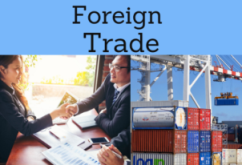
International Trade of Ecuador.
- Thanks to its geographical location, Ecuador has an appropriate climate for growth of many agricultural export products
- Ecuador has an international reputation as a reliable seafood and aquaculture products supplier, the manufacturing industry is known for its strengths in design, quality, and reliability
- Ecuador exports to 150 countries
- Ecuador exports 14,000 million dollars, 50% belongs to petroleum sector and 50% of non-traditional and traditional exports
- Export growth: 6.7%
- Import growth: 2.2%
- Ecuador is the largest bananas, palm of hearts, balsa wood, passion fruit juice, and roses exporter in the World
- Ecuador is renowned for its high-quality food products, including cocoa, coffee, aromatic, and medicinal plants
- The largest import partners of Ecuador are Latin America excluding the Andean Community 37%, the U.S. 25%, the Andean Community 22% Asia 19%, and the EU 10%
- The Port of Guayaquil handles a majority of the international trade of Ecuador; it is the economic capital of Ecuador
- Other important ports of Ecuador are Esmeraldas, Manta and Puerto Bolívar (banana). A larger bulk of international trade takes advantage of ocean routes. Every year, there are over 2,500 vessels that leave from Ecuadorian ports
Ecuador is:
- World's leading bananas exporter
- The first palm hearts exporter
- The first roses exporter
- The third largest flower exporter
Ecuador is a member of the Andean Community and associated to the MERCOSUR
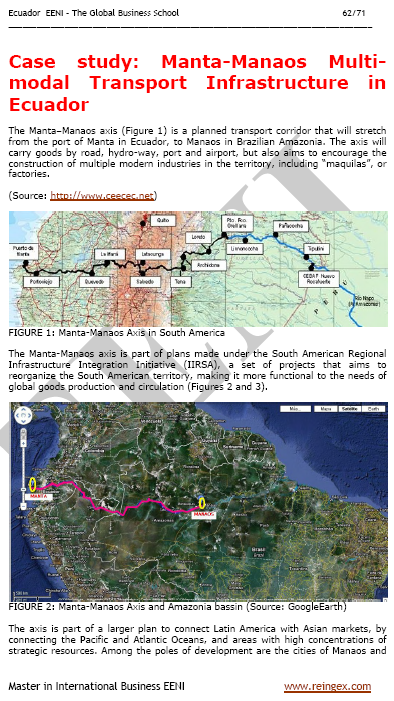
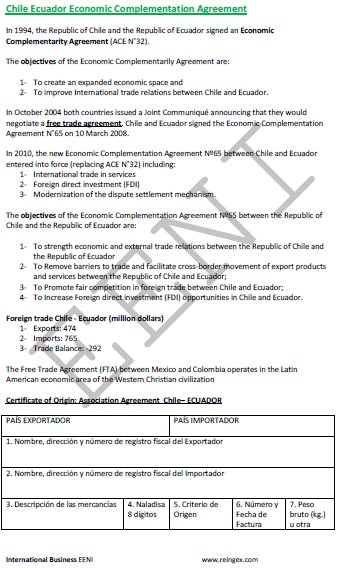
(c) EENI Global Business School (1995-2024)
We do not use cookies
Top of this page


